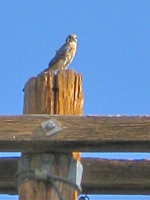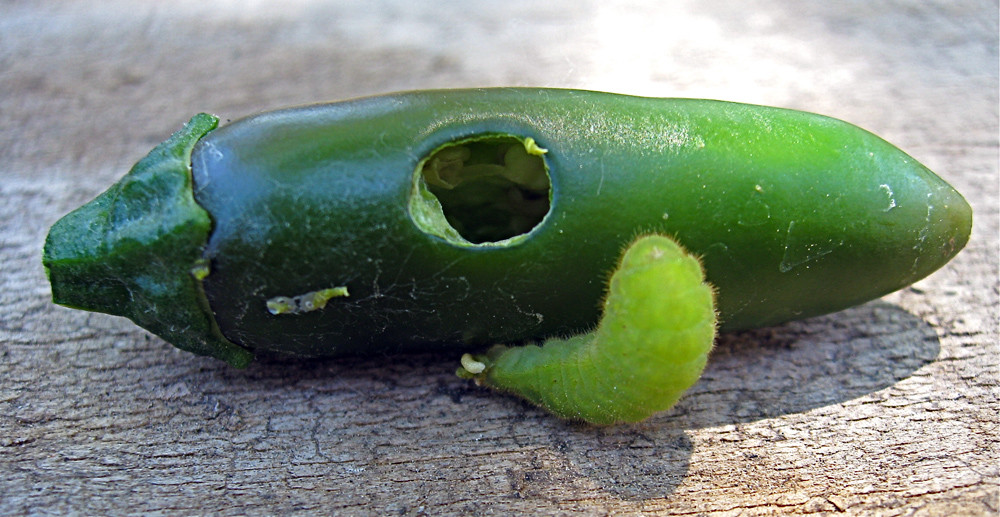… I missed at first, when outside friday morning shooting passionflowers.
It really irked me to not have my own photo of a Gulf Fritillary to post yesterday, so once the sun was higher, I went out to fetch one, if possible (a photo, that is, not a flutterby). I ended up encountering not only the butterfly, but three other notable things. Here they are, in the order they appeared (be sure to click to enlarge, except the kestrel, which is too blurry to bother, and actually will just get smaller anyway; all photos A.Shock):
A. The Gulf Fritillary, which started it all. The insect is sort of hidden in the negative space between stems and leaves (almost a “Spot the Bird“). This was the best photo I was able to nab — the name flitirraries would suit them even better, because they never seem to rest. They are Passiflora specialists, and are clearly thrilled that we have four vines in the yard. (Well, six vines actually — this morning I found two small seedlings, thriving about 4 feet away from where their parent plant refused to take.) >>
space between stems and leaves (almost a “Spot the Bird“). This was the best photo I was able to nab — the name flitirraries would suit them even better, because they never seem to rest. They are Passiflora specialists, and are clearly thrilled that we have four vines in the yard. (Well, six vines actually — this morning I found two small seedlings, thriving about 4 feet away from where their parent plant refused to take.) >>
B. The Echinopsis in bloom (or “Easter Lily cactus”). This one is a cultivar, I don’t know which, since these shade-growing cactus have  been living in this yard longer than we have. In my experience, it’s unusual to find its crepuscular flowers still open at noon. <<
been living in this yard longer than we have. In my experience, it’s unusual to find its crepuscular flowers still open at noon. <<
 C. The Fearsome Predator. >> The neighborhood male American Kestrel, about the size of a Mourning dove, checking out the Dee-licious Finch Bar (the birdfeeders) for lunch. I looked up when I heard a house sparrow give a rough alarm call; the little falcon was just 20 feet away from me, perched on a low wire with a good view of the menu. Unfortunately, I didn’t get a shot of him until he’d swooped up to the top of the corner phone pole because my trigger finger was distracted by D:
C. The Fearsome Predator. >> The neighborhood male American Kestrel, about the size of a Mourning dove, checking out the Dee-licious Finch Bar (the birdfeeders) for lunch. I looked up when I heard a house sparrow give a rough alarm call; the little falcon was just 20 feet away from me, perched on a low wire with a good view of the menu. Unfortunately, I didn’t get a shot of him until he’d swooped up to the top of the corner phone pole because my trigger finger was distracted by D:
D. The Ants that were biting me painfully on the feet. Due to hastily brushing them off and sweeping them out from under my sandal straps in a undignified quick-time version of the Myrmex Dance I did not immortalize their image, although they were just doing their job, Protecting The Nest, which I’d accidentally trodden upon trying to photograph the Echinopsis. Perhaps the Gilded Flicker family who lives here (and who, I think surprisingly late, just fledged a young’un) will be making a visit to the Dee-licious Ant Bar.
Do you suppose the Ant Bar has a Formica countertop?
Bonus etymology: Formica, etc.
According to the archives of “Word of the Day” — …Greek murmex [is] “an ant,” which also gives us myrmecology “the study of ants” and myrmecophagous “ant-eating.” In Latin the related word for ant was “formica,” from which we have the former Word of the Day “formication,” the sensation of ants crawling under the skin. The proprietary name “Formica” applies to a plastic laminate ultimately derived from formic acid (which comes from ants), but it is also a pun—it was originally developed as an electrical insulator that could be substituted “for mica.”
For the detail-oriented, let me add that Latin formīca is the ancestor of the French and Spanish words for ant, fourmi and hormiga, respectively. The Latin and Greek words formīca and myrmex (μύρμηξ) at first glance may not seem similar to each other, but as neatly summarized by Wikipedia, both are generally accepted to be derived from the Proto-Indo-European root *morwi- along with a pile of words for ant in other languages: Latin formīca, Iranian /moirbant, Avar maoiri, Sanskrit वम्र (vamra), Greek μύρμηξ (murmēks)/μυρμήγκι (mirmigi), Old Norse maurr, Crimean Gothic miera, Armenian մրջիւն (mrǰiwn), Polish mrówka, Albanian morr, Persian /murče, Old Church Slavonic mravie, Russian муравей (muravej), Tocharian /warme, Kurdish Mérú, Breton merien.
 It’s not every day a big red tour coach pulls up in front of the house to let people off.
It’s not every day a big red tour coach pulls up in front of the house to let people off. groups of visitors came by Three Star Owl and other studios in the neighborhood to see what we’re up to.
groups of visitors came by Three Star Owl and other studios in the neighborhood to see what we’re up to. burnished as it gets and open for visitors. I set up a table just outside its door, and demo’d a large coil owl and stamped raven mugs. And E had spiffed up the yard and plants to such a degree that ladies were trying to buy some of the cactus with beautiful spring blooms on them right off of his shelves.
burnished as it gets and open for visitors. I set up a table just outside its door, and demo’d a large coil owl and stamped raven mugs. And E had spiffed up the yard and plants to such a degree that ladies were trying to buy some of the cactus with beautiful spring blooms on them right off of his shelves.
















